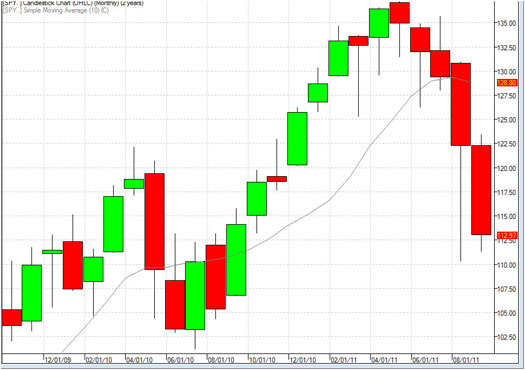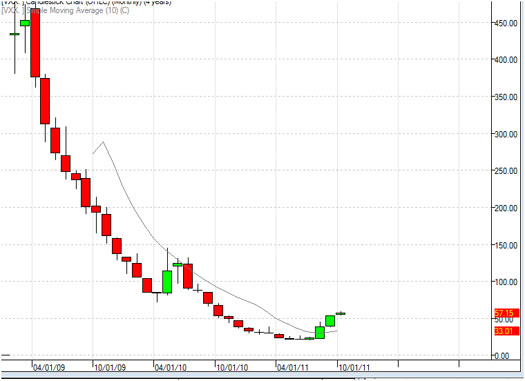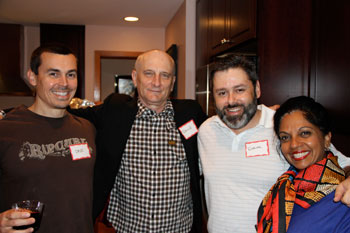Tharp's Thoughts Weekly Newsletter (View On-Line)
-
Article What's Next, RJ? by Van K. Tharp, Ph.D.
-
-
Trading Tip Learning from the Past Rather Than Living in It by D.R. Barton, Jr.
-
Mailbag Position Sizing™ Strategies and Volatility
-
Winter 2012 Workshop Schedule:
We'll Spend January in the States and February in Australia!
Learn More...

by Van K. Tharp, Ph.D.
RJ’s most recent Project Marathon article gave me the perfect opportunity to review his progress and provide some advice. Since he has been sharing his progress with you, I thought it would be appropriate to also share my response. I hope that the suggestions I am giving RJ also help a number of our readers who may be in a similar position.
Five Phases
Our Super Trader program has five different phases. The first phase is to master Tharp Think. This material is provided in the books Trade Your Way and Super Trader, as well as on our web site. In addition, in I occasionally present a low-cost Tharp Think workshop.
The second phase is to strongly work on one’s personal psychology. I think I have strengthened this phase over the years, especially with the addition of the Oneness Awakening Workshop. Originally, Super Traders had to pass a lengthy “test” and document five major transformations. My belief was that when you have mastered yourself through five major transformations, you could handle whatever else comes up in your life. Now, we have updated this phase to include 16 lessons that incorporate the old Super Trader test material and much more. When Super Traders complete this part of the program, they earn a psychological completion status. Most people who complete this phase say that their lives have improved dramatically, but personal growth doesn’t end here. Because transformation is continual, current Super Traders develop an ongoing self-work program. This was not part of the program when RJ went through it.
The third phase is to develop a business plan. This plan is a working document, at least 100 pages long, which guides you through your trading life. We teach what to include in this document in the Blueprint for Trading Success Workshop.
The fourth phase is to develop three non-correlated systems that are designed to work under different market conditions. You have to understand these systems thoroughly and know when they will work and when they won’t work. And I expect each system to have an SQN® score of at least 2.5 for the market types in which you plan to trade them. We teach numerous systems in our workshops that meet these criteria; however, most people seem to have a need to develop their own systems that fit them, which is why this step can take a lot of time.
The final phase is to demonstrate that you can make 100 trades with one or more of these systems at 95% efficiency or better. This means that you don’t make more than one mistake (of not following your rules) every 20 trades. Only when this phase is complete are you considered a graduate of the program.
What Happened
I have traders in the program that stop progressing at some point. “Getting stuck” happens! And I have written about ways to get around it. When a Super Trader gets stuck, I readily provide advice. Sometimes they follow it, and sometimes they don’t. Usually, they get stuck because they have skipped important, psychological steps.
When RJ entered the Super Trader program, he was working at IBM in a demanding role with worldwide responsibilities putting in 60+ hour weeks. He could only devote one hour each day to the Super Trader program and a few more hours on the weekend. I approved his business plan and only one system for him to trade. As I remember, that system was not approved for trading in strong bear markets like we are in now.
Thus, he completed the first three phases of the program in his two years and his name is on the Super Trader completion plaque. At that point, RJ’s two years were up, and he stopped sending weekly progress reports. He then started working for me researching and developing new products.
I thought RJ’s Project Marathon articles would give me a sense of how he was doing on the final phases of his development into a Super Trader. Encouraging him to write those articles was the only supervision I have given him since he had completed the program.
The Power of Questions
In RJ’s article, he listed three questions you need to ask when you are stuck:
- What happened?
- What’s missing?
- What’s next?
We teach this process in the Peak Performance 202 Workshop. You can ask yourself these questions whenever you seem to get stuck, or you produce results that did not meet your objectives.
It was encouraging to read that RJ desires to get out of this stuck state. I’ve already covered what happened. So, below are my thoughts on what’s missing and what’s next for RJ.
What’s Missing
- Ongoing Self-work: There is opportunity for a lot of powerful change work happening right now. While RJ completed work on his personal psychology in Phase 2, he needs to develop an ongoing self-work program and continue his personal evolution.
- Three Market-Type Specific Systems: If RJ decided to continue in the Super Trader program, for him to graduate he would need to develop two more systems that work for him. This would include one that works well in bear markets or strong bear markets. His goal was to make 131R in his first year, which is achievable (another of our Super Traders made 134R in one month last year). He also needs to document that those systems work to my satisfaction.
- 95% Efficiency: When those systems are approved, RJ needs to demonstrate that he can trade them with 95% efficiency.
- Trading in the Now: Beyond those core steps, RJ needs to practice trading in the now. I taught a Trading in the Now Workshop to the Super Traders last year. That course was three days of Oneness followed by a day focusing on how to trade in the now. It’s given each year after the Super Trader Summit, and it is only for Super Traders. It works extremely well, but it requires that you work diligently to get into the appropriate mental state and stay there while trading. (You are not there if you can talk while you are trading.)
An Example of Trading in the Now
While trading in the now can be applied to any time frame, it is easily applied in longer term trading simply by using monthly bars. You won’t make a lot of money here, but it’s part of how I trade the Van Tharp Institute retirement account. And I think I outperform most funds. Let me show you some graphs about what is going on right now.
The first is the monthly candlestick chart of the S&P 500, which I showed in last week’s update of the market. It was current through September 30th—it doesn’t include the up move that we have had so far in October. I first said that we were in a bear market in June 2011. And that became a strong bear in August 2011. The upward movement so far in October has not taken us out of the bear market mode.

When we first went into bear market mode, it was bear normal. That type of market is almost non-existent: bear markets are always associated with volatility. So let’s look at a monthly chart of the VXX (an ETF for volatility).

In March 2009, the VXX reached a peak of about 460. It then went into a free fall. When I said we were entering into a bear market with low volatility a few months back, VXX was forming a very narrow base in the low 20s. This gave a huge reward-to-risk trade.
Think about it. We were in a bear market, which is almost always associated with high volatility, however, VXX was basing at about 95% below its prior bear market high. You could take a very logical trade for 2-3 points of risk with a potential reward of 100 points or more. Does that make sense to you? We were going into a bear market and the volatility was 22!
I personally got into this trade for the VTI retirement account as a hedge for some positions that were giving me an income of 15% per year but still had downside potential. I got in at 22.04 on July 12th. My stop was at 19.8, which would have been an all-time low (and in a bear market!). VXX is currently way up from my entry, and I have a lot of room to let it ride if it wants to go to its old highs. At the time of this writing, the position was up 15.6R with the potential for 100R in profit. That’s trading in the now—being aware of what the market is doing with no internal chatter telling you that it might do something else.
I could give a lot of other examples—there is hardly a short position that would not have made a lot of money since I said we were in a bear market. And it would be completely possible to make 100R in one month going short in day trades.
What’s Next
So where should RJ go from here?
- Develop at least three systems and have them approved by me before you begin trading again.
- Make sure you have at least one system that will perform well in bear and strong bear markets.
- Do everything you can to work on being able to get into the “trading in the now” state. This includes developing an ongoing self-work program.
Perhaps we’ll see a new set of articles from RJ on “continuing my Super Trader experience.”
About the Author: Trading coach, and author, Dr. Van K. Tharp is widely recognized for his best-selling books and his outstanding Peak Performance Home Study program—a highly regarded classic that is suitable for all levels of traders and investors. You can learn more about Van Tharp at www.vantharp.com.
Trading Education
$700 Early enrollment discounts expire in just a few weeks on these outstanding workshops in November.
| Nov 12-13 |
$2,295
$2,995
|
Core Trading Systems: Market Outperformance and Absolute Returns
Learn longer term systems that only require a short amount time each week to trade.
Presented by Ken Long |
Cary, NC |
| Nov 14-16 |
$2,295
$2,995
|
How to Develop a Winning Trading System That Fits You
Learn the key elements to outstanding trading systems so you can build your own systems or properly adapt other systems to fit you.
Presented by RJ Hixson and Ken Long |
Cary, NC |
Click here to see our full workshop schedule with details
Click here to see locations, logistics, etc.
Read a recent interview with Ken Long

Trading Tip
Learning from the Past Rather Than Living in It
by D.R. Barton, Jr.
This week I am writing from my hometown in Virginia where the leaves are starting to turn in the Blue Ridge Mountains and the setting is almost surreal. I am here to celebrate my grandma’s 93rd birthday.
I realize now that I took so much for granted growing up here. The natural beauty of the area, with all of the elevation changes, is amazing. Toss in the yellow, orange and red leaves on the trees, and you have a rich tapestry that has to be seen to be believed.
In the midst of this splendor, my grandma leads a gracious life in a house on the hills. Grandma Megs gardens, cooks and cleans, and is an active leader in her local church. She still drives to the market, church, and all over her little town visiting friends and shut-ins. This past Saturday, her church participated in the Heritage Day fair, and my grandma was right in the middle of it. She single-handedly made 301 biscuits!
While the good health and active life that she enjoys is enviable, what impresses me most about Grandma Megs is the grace and kindness with which she leads her life. She treats everyone she encounters with kindness, compassion and joy. And she has a way to make you feel better after an interaction with her: an encouraging word, a gentle touch or a simple act of kindness leaves a wake of positive energy with all those around her.
As I reflect on Grandma Megs, I have found that there are two types of people who have reached a certain age and experience level—those that are inwardly focused and those that are outwardly focused.
Inwardly-focused people tend to talk about their infirmities and recount past happenings. They relive past glories and avoid past misfortunes.
Outwardly-focused folks concentrate on what they’re going to do next. They talk very little about their own aches and pains but are keenly aware of the situations of those around them. While they have learned from the past, they don’t dwell on it. Instead, they use past experiences as a guide to help them understand how they can best spend their time in the future.
As traders and investors, we can learn much from these two types of experienced folks.
In my interactions with thousands of traders and investors, I’ve found similar issues with their focus.
Inward or Outward Focus in Trading
Inwardly-focused traders and investors often make decisions based on whether they can be perceived to be right rather than whether the decision pattern will be profitable in the long run. This need to be right reflects the tendency of inwardly-focused traders to overemphasize how trades or investments make them look. Traders with this inward focus tend to emotionally relive trades from the past, especially a particularly good or bad trade. This drives traders to change their decision making process based on the emotional impact of prior trades (and on events from a small sample size).
On the other hand, outwardly-focused traders care less about how they’ll be perceived and more about what is useful and works. Outwardly-focused traders live in the present with a bias toward the future. They learn from past trades and move on. They don’t let the outcome of individual trades change their decision making process.
I don’t want the labels I’ve used here to throw anyone off. There are many internally-focused activities that are useful for traders and investors. Personal development and looking inside one’s self to understand your trading and investing psychology are critical to trading success.
The great take away is that trading, like life, is best experienced by focusing on what’s happening now with a bias toward future results and activities. When you get caught up or overly influenced by what has happened in the past, you open yourself up to decision making biases that diminish enjoyment and results. It’s a way of life that my grandma has taught me and that will serve us all well!
Great Trading,
D. R.
About the Author: A passion for the systematic approach to the markets and lifelong love of teaching and learning have propelled D.R. Barton, Jr. to the top of the investment and trading arena. He is a regularly featured guest on both Report on Business TV, and WTOP News Radio in Washington, D.C., and has been a guest on Bloomberg Radio. His articles have appeared on SmartMoney.com and Financial Advisor magazine. You may contact D.R. at "drbarton" at "vantharp.com".

Peak Performance Home Study Program for Traders and Investors
YOU are the most important factor in your trading success!
You create the results you want. Going through this home study course, you’ll gain a perspective on the "how" and "why" of your past trading results and learn techniques to increase profits and reduce stress.
Your success as a trader depends upon the amount of work you put into applying the principles of the course to your investing and trading. Get started now and take charge of your trading success!
Learn More
Buy Now
Mailbag
Position Sizing™ Strategies and Volatility
Q:I learned about position sizing™ strategies after purchasing Trade Your Way. In theory, it sounds useful, but its practical significance, in my experience, is limited.
The problem is the extreme volatility that characterizes normal equity and
ETF price fluctuations in the stock market (my focus). Price moves over even
short and intermediate periods are extreme, even acknowledging differences
in volatility between issues (which itself constantly changes).
When I have employed a position sizing formula to cope with the real-life
volatility, resulting position sizes are so small that even a $10 commission
on each side of the trade is significant, and capital gains, even if
substantial in percentage terms, are not.
If, instead, I adjust position size to invest a meaningful amount of capital
in dollar terms, the price fluctuations are far too great to fit within the
narrow "% greatest loss" figure used in the calculations.
Despite making all kinds of adjustments, I have never been able to devise a
way around this dilemma, so I assume there is none.
A: Volatility says something about where your stop should be, not the usefulness of position sizing strategies.
So let's say you buy an ETF at 40. You put you stop 25% away at 10, which
should be way below the volatility.
You want to risk 1%, and you have a $100,000 account. Thus, you risk $1,000. Since
your individual risk is $10, you can buy 100 shares.
And you can use position sizing strategies based upon volatility: 1%
volatility instead of 1% risk. If the volatility is 7 points, you could use 3 times volatility as your risk or $21.
And all of this assumes you want long-term positions. Day trading doesn't change that much under bear market conditions, and it should be based upon the volatility of the bars.
Ask Van...
Everything that we do here at the Van Tharp Institute is focused around helping you improve as a trader and investor. Therefore, we love to get your feedback, both positive and negative!
Click here to take our quick, 6-question survey.
Also send comments or ask Van a question by using the form below.
Click Here for Feedback Form »
Back to Top
Fun
Click here to see fun photos from last month's client dinner!

Contact Us
Email us [email protected]
The Van Tharp Institute does not support spamming in any way, shape or form. This is a subscription based newsletter.
To change your e-mail Address, click here
To stop your subscription look at the very bottom, left corner of this email and click on that link.
How are we doing? Give us your feedback! Click here to take our quick survey.
800-385-4486 * 919-466-0043 * Fax 919-466-0408
SQN® and the System Quality Number® are registered trademarks of the Van Tharp Institute
Back to Top |